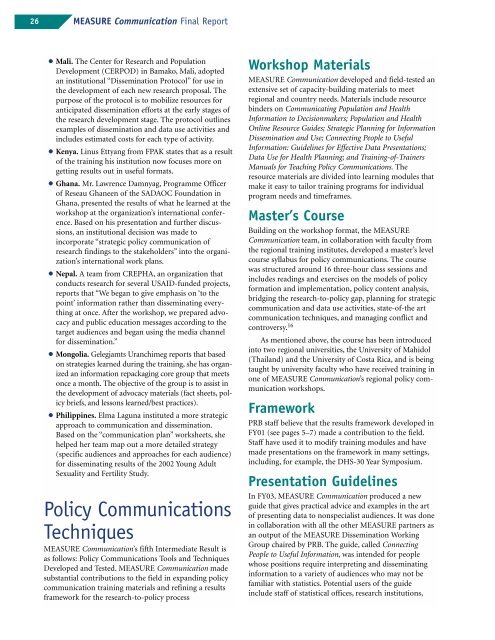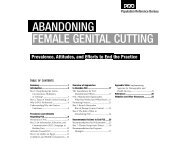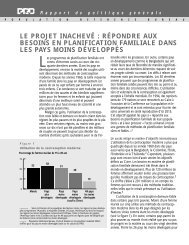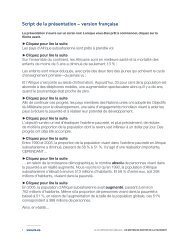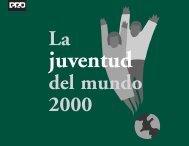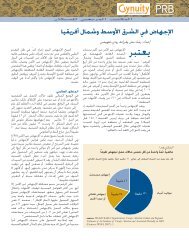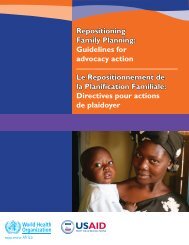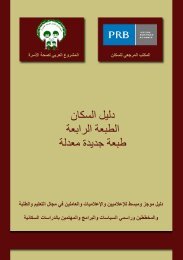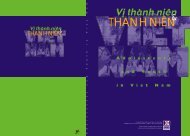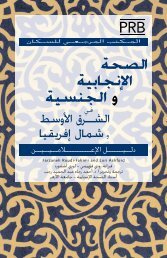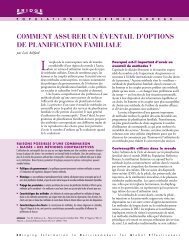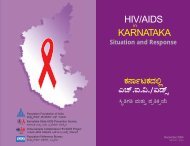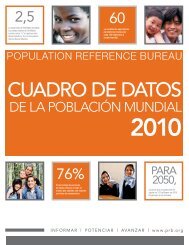MEASURE Communication Final Report - Population Reference ...
MEASURE Communication Final Report - Population Reference ...
MEASURE Communication Final Report - Population Reference ...
Create successful ePaper yourself
Turn your PDF publications into a flip-book with our unique Google optimized e-Paper software.
26 <strong>MEASURE</strong> <strong>Communication</strong> <strong>Final</strong> <strong>Report</strong><br />
● Mali. The Center for Research and <strong>Population</strong><br />
Development (CERPOD) in Bamako, Mali, adopted<br />
an institutional “Dissemination Protocol” for use in<br />
the development of each new research proposal. The<br />
purpose of the protocol is to mobilize resources for<br />
anticipated dissemination efforts at the early stages of<br />
the research development stage. The protocol outlines<br />
examples of dissemination and data use activities and<br />
includes estimated costs for each type of activity.<br />
● Kenya. Linus Ettyang from FPAK states that as a result<br />
of the training his institution now focuses more on<br />
getting results out in useful formats.<br />
● Ghana. Mr. Lawrence Damnyag, Programme Officer<br />
of Reseau Ghaneen of the SADAOC Foundation in<br />
Ghana, presented the results of what he learned at the<br />
workshop at the organization’s international conference.<br />
Based on his presentation and further discussions,<br />
an institutional decision was made to<br />
incorporate “strategic policy communication of<br />
research findings to the stakeholders” into the organization’s<br />
international work plans.<br />
● Nepal. A team from CREPHA, an organization that<br />
conducts research for several USAID-funded projects,<br />
reports that “We began to give emphasis on ‘to the<br />
point’ information rather than disseminating everything<br />
at once. After the workshop, we prepared advocacy<br />
and public education messages according to the<br />
target audiences and began using the media channel<br />
for dissemination.”<br />
● Mongolia. Gelegjamts Uranchimeg reports that based<br />
on strategies learned during the training, she has organized<br />
an information repackaging core group that meets<br />
once a month. The objective of the group is to assist in<br />
the development of advocacy materials (fact sheets, policy<br />
briefs, and lessons learned/best practices).<br />
● Philippines. Elma Laguna instituted a more strategic<br />
approach to communication and dissemination.<br />
Based on the “communication plan” worksheets, she<br />
helped her team map out a more detailed strategy<br />
(specific audiences and approaches for each audience)<br />
for disseminating results of the 2002 Young Adult<br />
Sexuality and Fertility Study.<br />
Policy <strong>Communication</strong>s<br />
Techniques<br />
<strong>MEASURE</strong> <strong>Communication</strong>’s fifth Intermediate Result is<br />
as follows: Policy <strong>Communication</strong>s Tools and Techniques<br />
Developed and Tested. <strong>MEASURE</strong> <strong>Communication</strong> made<br />
substantial contributions to the field in expanding policy<br />
communication training materials and refining a results<br />
framework for the research-to-policy process<br />
Workshop Materials<br />
<strong>MEASURE</strong> <strong>Communication</strong> developed and field-tested an<br />
extensive set of capacity-building materials to meet<br />
regional and country needs. Materials include resource<br />
binders on Communicating <strong>Population</strong> and Health<br />
Information to Decisionmakers; <strong>Population</strong> and Health<br />
Online Resource Guides; Strategic Planning for Information<br />
Dissemination and Use; Connecting People to Useful<br />
Information: Guidelines for Effective Data Presentations;<br />
Data Use for Health Planning; and Training-of-Trainers<br />
Manuals for Teaching Policy <strong>Communication</strong>s. The<br />
resource materials are divided into learning modules that<br />
make it easy to tailor training programs for individual<br />
program needs and timeframes.<br />
Master’s Course<br />
Building on the workshop format, the <strong>MEASURE</strong><br />
<strong>Communication</strong> team, in collaboration with faculty from<br />
the regional training institutes, developed a master’s level<br />
course syllabus for policy communications. The course<br />
was structured around 16 three-hour class sessions and<br />
includes readings and exercises on the models of policy<br />
formation and implementation, policy content analysis,<br />
bridging the research-to-policy gap, planning for strategic<br />
communication and data use activities, state-of-the art<br />
communication techniques, and managing conflict and<br />
controversy. 16<br />
As mentioned above, the course has been introduced<br />
into two regional universities, the University of Mahidol<br />
(Thailand) and the University of Costa Rica, and is being<br />
taught by university faculty who have received training in<br />
one of <strong>MEASURE</strong> <strong>Communication</strong>’s regional policy communication<br />
workshops.<br />
Framework<br />
PRB staff believe that the results framework developed in<br />
FY01 (see pages 5–7) made a contribution to the field.<br />
Staff have used it to modify training modules and have<br />
made presentations on the framework in many settings,<br />
including, for example, the DHS-30 Year Symposium.<br />
Presentation Guidelines<br />
In FY03, <strong>MEASURE</strong> <strong>Communication</strong> produced a new<br />
guide that gives practical advice and examples in the art<br />
of presenting data to nonspecialist audiences. It was done<br />
in collaboration with all the other <strong>MEASURE</strong> partners as<br />
an output of the <strong>MEASURE</strong> Dissemination Working<br />
Group chaired by PRB. The guide, called Connecting<br />
People to Useful Information, was intended for people<br />
whose positions require interpreting and disseminating<br />
information to a variety of audiences who may not be<br />
familiar with statistics. Potential users of the guide<br />
include staff of statistical offices, research institutions,


